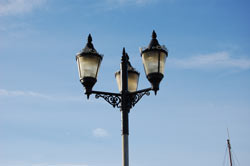Nikon AF-S DX 18-55 f/3.5-5.6 G EDII
Nikon’s new standard ‘kit’ lens is being packaged with the new D40 dSLR but is also available on it’s own. Re-designed from the original that was released with the D50, we take a look at how it performs.
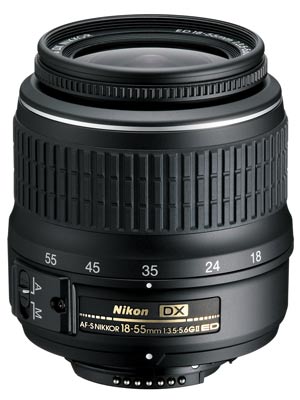 Specification
Specification
- Focal Length 18-55mm
- Construction 7/5 elements/groups
- Max aperture f/3.5-5.6
- Angle of view equivalent to 27-82.5mm in 35mm format
- Closest focus 0.2m
- Filter thread 52mm
- Dimensions 69x85mm approx
- Weight 0.205kg
- Hood not supplied
- Price £149.99
Build and handling
The barrel of this lightweight lens is dominated by the 21mm of rubberised grip that is the zoom ring. There is an AF/MF switch in the usual place on the left, just in front of the mount and a token manual focus ring forward of the zoom ring that is some 5mm wide. The mount is constructed of engineering plastics that do seem a little more advanced than some others on the market, showing no signs of wear after a good number of lens changes.
The lens extends when zoomed by way of a trombone action both towards the wide end and the telephoto end, with a rest position around the 35mm mark. Focussing further extends the front element, and this time, rotates the element also. The lens is finished off with a small flange that has no provision for a hood.
The zoom ring produced a smooth transition through the marked focal lengths of 18, 24, 35, 45 and 55mm and manual focussing is achieved by rotating the front element.
Nikons new, lightweight SWM focussing system is quiet and fast enough for most purposes and I found it accurate in good light conditions with only the occasional hunt as the light lowered. However, in common with other lenses in this class, the AF cannot be over-ridden with the MF ring and for difficult subjects the AF needs to be switched off to use the manual ring. Although at first glance this looks to be a token affair, its position at the front of the zoom ring and the drop in diameter of the lens at this point makes it very usable.
Optical quality
This lens is designated as a DX lens, signifying its use is restricted to the cropped sensors of Nikons digital cameras and is not suitable for their film based cousins as they will vignette significantly.
The performance of this lens is impressive in the centre but average towards the edges when used wide open. Like all of its ilk, the performance gets worse as the focal length increases and to get the optimum out of it the aperture needs closing down more nearer the longer end. Very good resolution figures, especially at the wide end, are produced by the optic but where this lens is let down badly is in the control of distortion, with figures of –3.79% barrel (un-acceptable) at the short end, going on to an acceptable-0.25% barrel at the longest focal length.
The lens also displayed a certain amount of chromatic aberration in high contrast areas, allowing light colours to bleed into darker ones, but this only occurs when used at the widest apertures. Contrast drops off slightly as the focal length increases, but not alarmingly so.]
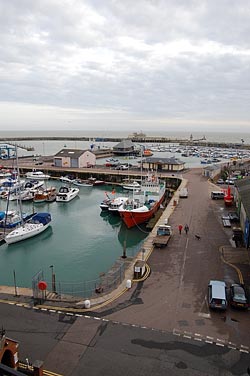 |  |
The zoom range works well on the DX sensor to pick out subjects. F/8 on D40
 Colours are rendered well with this lens on a D40 |
|
Click on each comparision photo below to view full size versions
Below is our lens test data. To find out how to use these graphs look at this article: How we test lenses
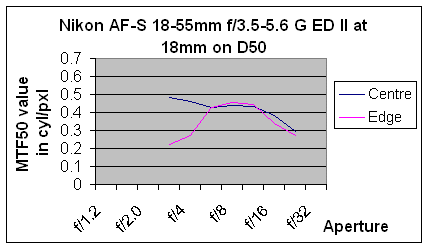
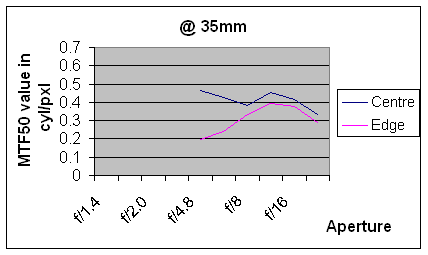
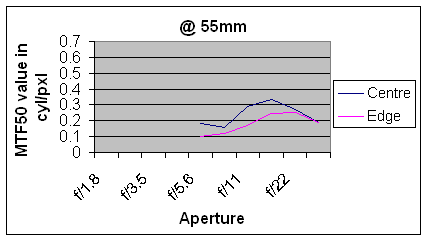
Verdict
Despite its lightweight construction this lens does not have too a ‘cheap’ feel to it and the overall performance, although not stunning, is certainly not in the milk-bottle category. The autofocus performed satisfactorily and the manual mode proved usable. For a ‘kit’ lens, the performance, especially at the wider end if you ignore the distortion, is quite good.
In summary, the positive points of the Nikon DX AF-S 55-200mm are:
![]() Smallest and lightest in class
Smallest and lightest in class
![]() Good performance especially at wider lengths
Good performance especially at wider lengths
![]() Good value for money
Good value for money
The negative points aree:
![]() Barrel distortion at the wide end.
Barrel distortion at the wide end.
![]() Front element rotates during focussing.
Front element rotates during focussing.
![]() Slight drop in contrast at longer end.
Slight drop in contrast at longer end.
Check the latest price for the Nikon DX AF-S 18-55mm f/3.5-5.6 G ED II here Available from December 2006
Discuss this lens and other related lens subjects here
Test by Ian Andrews www.wildaboutkent.com
Add your message
Please login here or if you've not registered, you can register here. Registering is safe, quick and free.
photodo Stats
428 MTF tests
74 in-depth photodo reviews
100+ users join each day
Help the lens community by reviewing or rating a lens today via our lens search
Latest Lens Reviews
- Chinon 28mm f/2.8 Vintage Lens Review
- Canon EF 70-200mm f/4L IS II USM Lens Review
- Samyang AF 85mm f/1.4 EF Review
- Sigma 70mm f/2.8 DG Macro Art Review
- Samyang AF 24mm f/2.8 FE Review
- Meike 50mm f/1.7 Review
- Tamron 70-210mm f/4 Di VC USD Review
- Lensbaby Burnside 35mm f/2.8 Review
- Asahi Super Takumar 50mm f/1.4 Review
- Asahi Super-Multi-Coated Takumar 135mm f/3.5 Review

